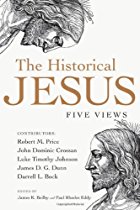Following Professor James McGrath’s advice to pay particular attention to E. P. Sanders’ discussion of methodology (pp.3-22 in Jesus and Judaism) I am here have a look at one of the main tests for the sayings material.
Sanders does not discuss any methodology for testing authenticity of biographical events in Jesus’ life. The closest he comes to this is an a priori analysis of the plot narrative: “If Jesus did X then he probably also did or meant or tried to do Y”, or “Since B happened to Jesus then it was probably because he did something like A.”
He does discuss a methodology for the sayings material. It is the criterion of double dissimilarity.
The principle test which scholars have recently used for assessing authenticity is the test of double ‘dissimilarity’ . . .
The test is this: material which can be accounted for neither as traditional Jewish material nor as later church material can be safely attributed to Jesus. (p. 16)
Sanders is well aware of difficulties with this.
There are well-known difficulties in applying the test. We know first-century Judaism very imperfectly, and knowledge about the interests of the church between 70 and 100 CE . . . is slender indeed.
Despite these two deficiencies in our knowledge, Sanders refers to the “Let the dead bury their dead” saying as one example where this test can be successfully applied. (But even this saying has been contextualized within pre-Christian Judaism’s and the early church’s beliefs in the sharp divide between the life of the true community of faith and the spiritual death of those outside. Fletcher-Louis, JSNT 26.1 (2003).) Nonetheless, Sanders continues:
Yet a problem remains. The test rules out too much.
It is this very “problem” of the test that is addressed by Robert Price, and as outlined earlier in 5 (more) commandments for historians:
And if the criterion of dissimilarity is valid, then we must follow unafraid wherever it leads. (Price in The Historical Jesus: Five Views, p.59)
Price argues that since every saying attributed to Jesus in the Gospels was written by “church” scribes and for church needs, it follows, by the criterion of dissimilarity, that every saying we have of Jesus is a creation for church needs.
Price appears to be directly responding to Sanders when he remarks that this criterion has been watered down by many scholars on the grounds that, applied consistently, it leaves virtually no sayings left to attribute to Jesus. But of course, we cannot justify a complaint about a method solely on the grounds that it does not yield the results we want.
Back to Sanders.
[T]he remaining material does not interpret itself or necessarily answer historical questions. It must still be placed in a meaningful context . . . .
Since historical reconstruction requires that data be fitted into a context, the establishment of a secure context, or framework of interpretation, becomes crucial. There are basically three kinds of information which provide help in this endeavour: such facts about Jesus as those outlined (. . . nos. 1-6); knowledge about the outcome of his life and teaching (cf. nos. 7 and 8); knowledge of first-century Judaism. (pp.16-17)
The numbers here refer to Sanders list of “facts about Jesus’ career and its aftermath which can be known without doubt. . . . The almost indisputable facts . . . are these” (p.11):
- Jesus was baptized by John the Baptist
- Jesus was a Galilean who preached and healed
- Jesus called disciples and spoke of their being twelve
- Jesus confined his activity to Israel
- Jesus engaged in a controversy about the temple
- Jesus was crucified outside Jerusalem by the Roman authorities
- After his death Jesus’ followers continued as an identifiable movement
- At least some Jews persecuted at least parts of the new movement (Gal. 1.13, 22; Phil. 3.6), and it appears that this persecution endured at least to a time near the end of Paul’s career (II Cor. 11:24; Gal. 5.11; 6.12; cf. Matt. 23.3; 10.17)
There is no evidence for any of the above apart from the Gospel narratives themselves. Some are disputed by some scholars (e.g. points 2, 3 and 5). And if such “facts” can only qualify as being “almost indisputable”, that hardly leaves them in the same class of what normally is taken as historical fact, such as Caesar crossing the Rubicon or the existence of itinerant sophists teaching around Athens from the fifth century b.c.e.
This absence of any way to determine the historical origin of the many of the Bible’s narratives has not gone unnoticed among some scholars: Continue reading “E.P. Sanders’ Test for Authenticity of the Sayings of Jesus”


 Robert M. Price lays out 5 ground rules for historical enquiry in his opening chapter, Jesus at the Vanishing Point, in
Robert M. Price lays out 5 ground rules for historical enquiry in his opening chapter, Jesus at the Vanishing Point, in 


